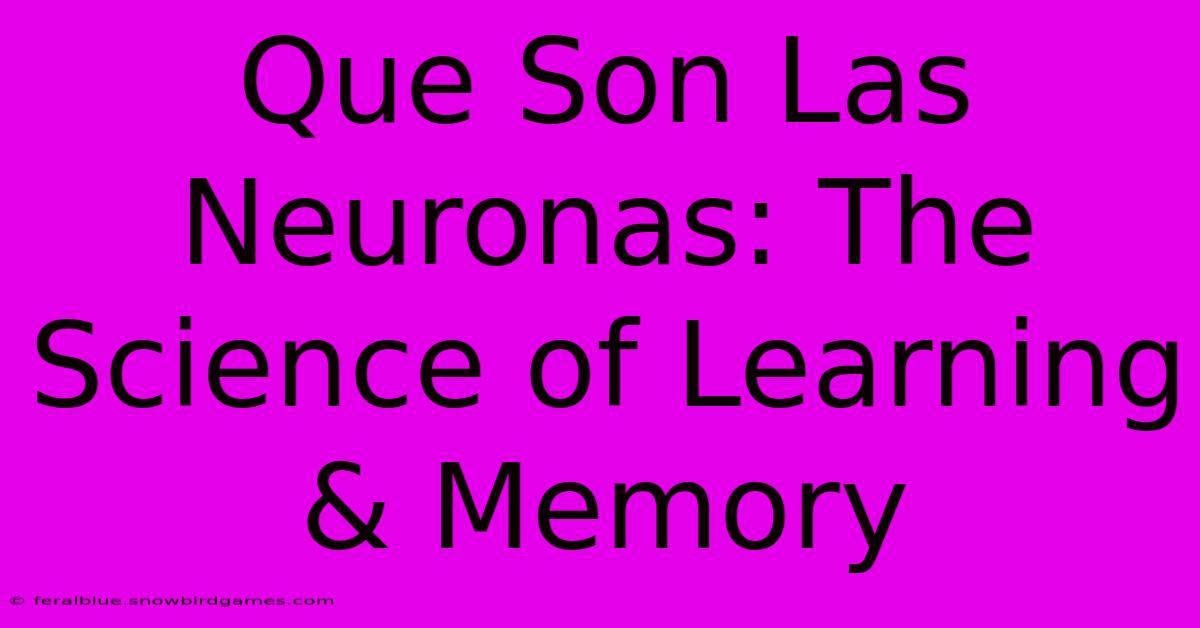Que Son Las Neuronas: The Science Of Learning & Memory

Table of Contents
Que Son Las Neuronas: The Science of Learning & Memory
Understanding how we learn and remember is a fundamental quest in neuroscience. At the heart of this process lies the neuron, the basic building block of our nervous system. But que son las neuronas? (What are neurons?) Let's delve into the fascinating world of these cells and uncover their role in learning and memory.
What are Neurons? The Tiny Architects of Thought
Neurons are specialized cells responsible for receiving, processing, and transmitting information throughout the body. Think of them as tiny, intricate communication devices, constantly exchanging signals to orchestrate every thought, feeling, and action. They achieve this through a complex network of connections, forming the intricate circuitry of the brain and nervous system.
Key Components of a Neuron:
- Dendrites: These branching extensions receive signals from other neurons. Imagine them as the "ears" of the neuron, listening for incoming messages.
- Cell Body (Soma): This central part of the neuron contains the nucleus and other essential organelles. It integrates the incoming signals from the dendrites.
- Axon: This long, slender projection transmits signals away from the cell body. Think of it as the "mouth" of the neuron, sending out its message.
- Synapse: This is the tiny gap between the axon of one neuron and the dendrite of another. It's where communication happens, through the release and reception of neurotransmitters. Neurotransmitters are chemical messengers that carry the signal across the synapse.
How Neurons Learn: Synaptic Plasticity
The remarkable ability of the brain to learn and adapt is largely due to synaptic plasticity. This refers to the ability of synapses to strengthen or weaken over time, depending on the frequency and pattern of neuronal activity. This process is at the core of learning and memory formation.
Two Main Types of Synaptic Plasticity:
- Long-Term Potentiation (LTP): This involves the strengthening of synaptic connections, making it easier for signals to pass between neurons. It's often associated with learning new information and forming memories.
- Long-Term Depression (LTD): This involves the weakening of synaptic connections, making it harder for signals to pass. It's important for refining existing connections and preventing the brain from becoming overloaded with information.
The Role of Neurons in Memory
Memory is not stored in a single location in the brain, but rather distributed across networks of interconnected neurons. Different types of memory rely on different brain regions and neuronal mechanisms.
Different Types of Memory:
- Short-term memory: This holds information briefly, for a few seconds to minutes. It's thought to involve transient changes in neuronal activity.
- Long-term memory: This stores information for extended periods, from days to a lifetime. It involves lasting changes in synaptic connections and the growth of new neuronal connections. Long-term memory can be further divided into:
- Declarative memory: This includes facts and events (e.g., remembering your phone number or what you ate for breakfast). It is often associated with the hippocampus and other cortical areas.
- Non-declarative memory: This encompasses skills and habits (e.g., riding a bike or playing the piano). It is often associated with the cerebellum and basal ganglia.
The Ongoing Research: Exploring the Mysteries of the Neuron
Research into neurons and their role in learning and memory is an ongoing and rapidly evolving field. Scientists are constantly uncovering new insights into the intricate mechanisms that govern these processes. Areas of active investigation include:
- The role of glial cells: While neurons are the primary signaling cells, glial cells play a crucial supportive role in neuronal function and plasticity.
- The impact of neurotrophic factors: These proteins influence neuronal growth, survival, and synaptic plasticity.
- The effects of aging and disease: Understanding how neuronal function deteriorates with age or in neurodegenerative diseases is crucial for developing effective treatments.
Conclusion: The Neuron – A Foundation of Cognitive Function
In conclusion, understanding que son las neuronas (what are neurons) is essential to comprehending the complexities of learning and memory. These remarkable cells, through their intricate communication and dynamic plasticity, form the very foundation of our cognitive abilities. Ongoing research promises to further illuminate the secrets of these fascinating cells and their critical role in shaping our minds.

Thank you for visiting our website wich cover about Que Son Las Neuronas: The Science Of Learning & Memory. We hope the information provided has been useful to you. Feel free to contact us if you have any questions or need further assistance. See you next time and dont miss to bookmark.
Featured Posts
-
Dangotes Naira Net Worth A Historical Perspective
Apr 04, 2025
-
Shahid Kapoor Age Celebrating His Achievements
Apr 04, 2025
-
Virat Kohli S Age What Can We Learn From His Journey
Apr 04, 2025
-
Maxine Waters Daughter Carrying The Torch
Apr 04, 2025
-
Faiq Bolkiahs Net Worth A Prince Among Billionaires
Apr 04, 2025
